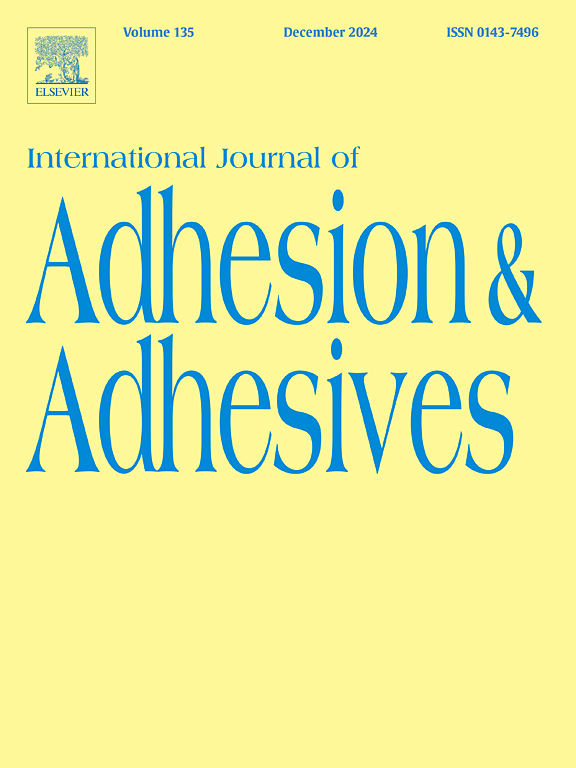基于 GSK-3 抑制剂的新型通用牙本质粘接系统:牙本质修复和提高粘接强度的综合分析
IF 3.2
3区 材料科学
Q2 ENGINEERING, CHEMICAL
International Journal of Adhesion and Adhesives
Pub Date : 2024-09-26
DOI:10.1016/j.ijadhadh.2024.103839
引用次数: 0
摘要
该研究旨在描述一种基于 GSK-3(糖原合成酶激酶-3)抑制剂(Tideglusib®)的新型通用粘合剂系统的配方,并评估其粘合强度和牙本质修复能力。将 Tideglusib® 添加到 Ultradent Peak 通用牙本质粘接剂中,制成实验粘接剂(最终浓度分别为 0.5%、1% 和 2%)。将这些粘合剂涂抹在牙齿上,然后切片、保存 24 小时或 2 年,然后测量粘合强度。使用三点弯曲试验测试粘合牙本质梁的基线刚度。进行动物实验是为了在使用粘合剂后为微计算机断层扫描成像提供样本。使用透射电子显微镜对胶原基质进行了评估。使用成纤维细胞测定了改性粘合剂的细胞毒性。分子建模评估了 Tideglusib® 分子与胶原蛋白和粘合剂成分上的活性位点的结合情况。测量了人牙本质基质中的 TGFβ-1/ 和 BMP-2,并使用 SkyScan 2211 扫描了界面。结果RMSD(均方根方差)分析表明,模拟与球蛋白的变化相平衡(p <0.05)。0.5 % 和 1 % Tideglusib® 组的标本在显微 CT 成像中显示出粘合剂渗透性,牙本质密度显著增加。同组的标本显示细胞有大量细胞质,并有局灶性粘附点。随着储存时间的延长,粘接强度明显降低(p < 0.05)。0.5 % 和 1 % Tideglusib® 组的 hTDM 中 TGFβ-1 和 BMP-2 逐渐释放(p < 0.05),弹性模量更高(p < 0.05)。结论在实验性通用粘合剂系统中加入 1 % 的 Tideglusib® 可提高粘合强度并促进牙本质修复。基于 Tideglusib® 的粘合剂可以保护牙齿结构的机械性能,促进再生能力,因此有望延长临床粘合修复体的使用寿命。本文章由计算机程序翻译,如有差异,请以英文原文为准。
Novel GSK-3 inhibitor based universal dentin bonding system: A comprehensive analysis of dentinal repair and improved bond strength
The aim of the study was to describe the formulation of a novel universal adhesive system, based on a GSK-3 (glycogen synthetase kinase-3) inhibitor (Tideglusib®), and to evaluate its bond strength and dentinal repair capability. Tideglusib® was added to Ultradent Peak Universal Dentin Bonding Agent to make experimental adhesives (0.5 %, 1 %, 2 % final concentration). They were applied to teeth which were sectioned, stored for 24 h, or 2 years then bond strengths measured. Baseline stiffness of bonded dentin beams was tested using the three-point bending test. Animal experiments were performed to provide specimens for microcomputed tomography imaging after adhesive application. Collagen matrix was evaluated using transmission electron microscopy. The cytotoxicity of the modified adhesives was determined using fibroblastic cells. Molecular modelling evaluated binding of the Tideglusib® molecule to active sites on collagen and the adhesive components. TGFβ-1/and BMP-2 in human dentin matrices were measured and interfaces were scanned using SkyScan 2211. Adhesives’ stability tests were done.
Results
RMSD (root mean square deviation) analysis indicated simulation has equilibrated with changes for globular proteins (p < 0.05). Specimens from 0.5 %, and 1 % Tideglusib® groups displayed adhesive penetration with Micro-CT imaging and a significant increase in dentin density was seen. Specimens from the same groups showed cells with large masses of cytoplasm with focal adhesion points. Bond strength decreased significantly (p < 0.05) with increased storage time. Gradual release (p < 0.05) of both TGFβ-1 and BMP-2 from hTDMs with 0.5 % and 1 % Tideglusib® groups occurred and higher elastic moduli (p < 0.05). Collagen-based amide and proline Raman bands were seen in the Tideglusib® groups.
Conclusion
Incorporation of Tideglusib® in experimental Universal Adhesive System at 1 % improved adhesive bond strength and promoted dentinal repair. Application of Tideglusib® based adhesive conserve mechanical properties of the tooth structure and promote regenerative capability so can be expected to extend the service life of adhesive restorations in clinical situations.
求助全文
通过发布文献求助,成功后即可免费获取论文全文。
去求助
来源期刊

International Journal of Adhesion and Adhesives
工程技术-材料科学:综合
CiteScore
6.90
自引率
8.80%
发文量
200
审稿时长
8.3 months
期刊介绍:
The International Journal of Adhesion and Adhesives draws together the many aspects of the science and technology of adhesive materials, from fundamental research and development work to industrial applications. Subject areas covered include: interfacial interactions, surface chemistry, methods of testing, accumulation of test data on physical and mechanical properties, environmental effects, new adhesive materials, sealants, design of bonded joints, and manufacturing technology.
 求助内容:
求助内容: 应助结果提醒方式:
应助结果提醒方式:


